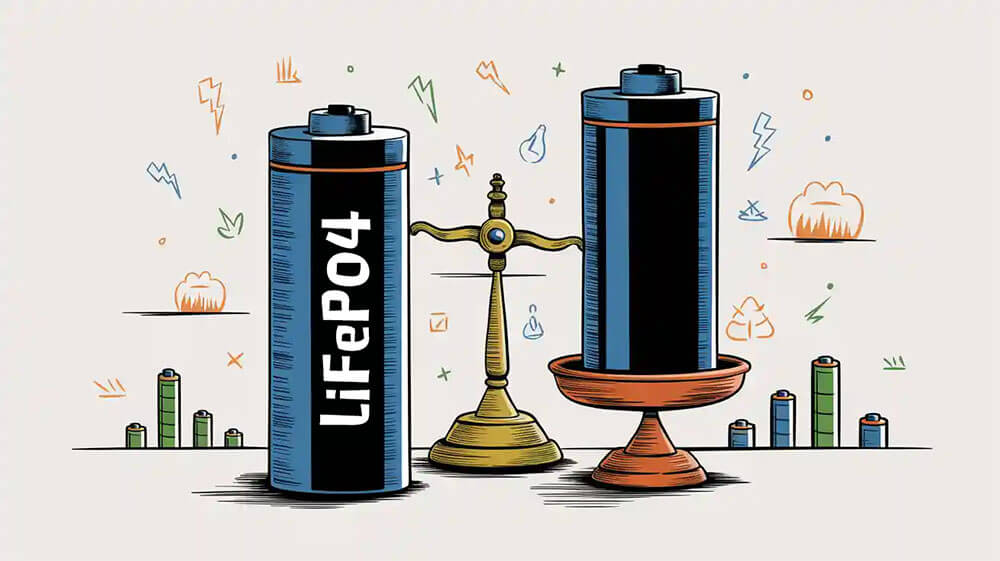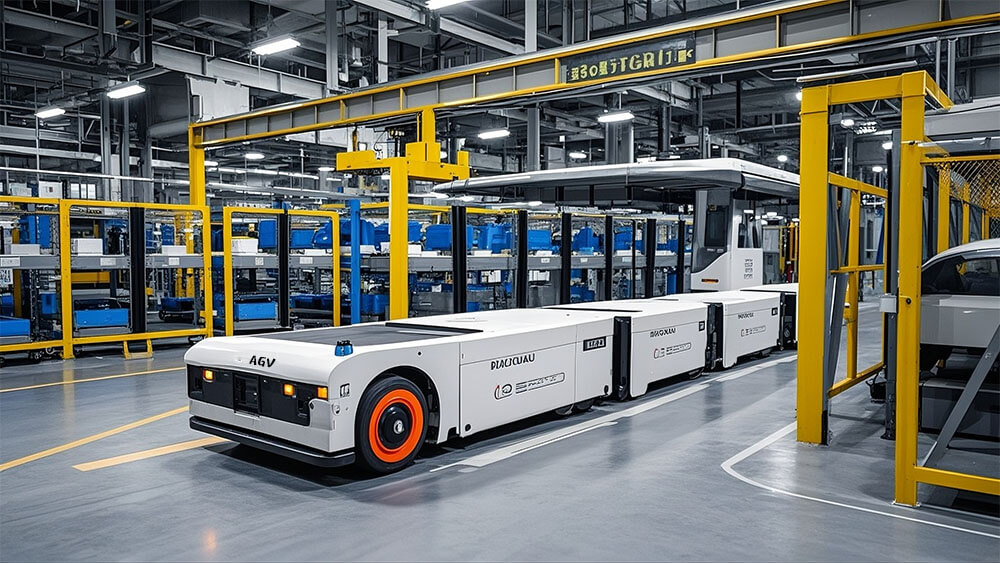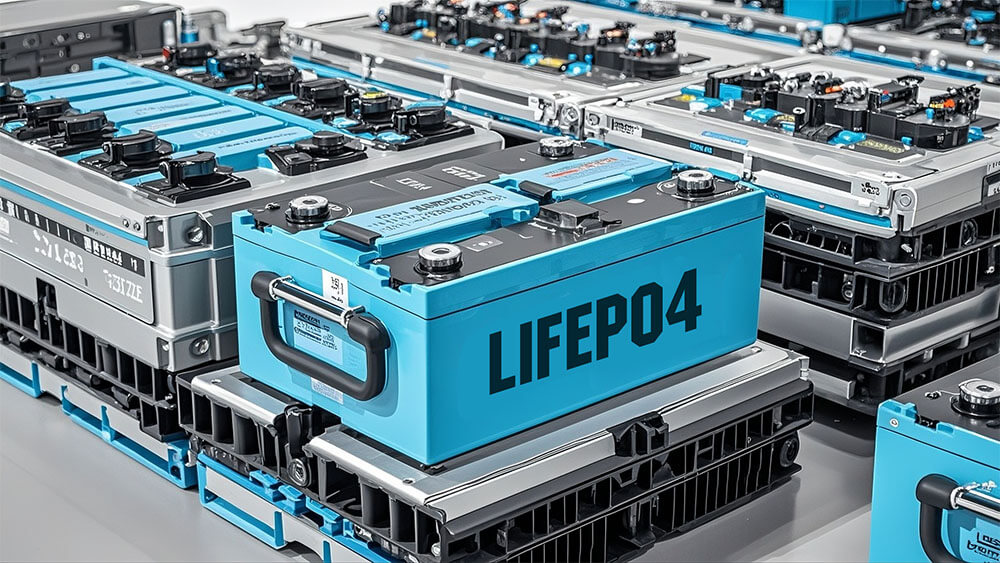Contents

Selecting the appropriate battery technology is essential for industries and businesses focused on enhancing performance and ensuring safety. The LiFePO4 battery has gained recognition as a dependable choice, thanks to its extended lifespan and superior safety characteristics. The market for LiFePO4 batteries is experiencing rapid growth, with its value expected to rise from USD 15.28 billion in 2023 to USD 124.42 billion by 2033, representing a CAGR of 25.8%. This remarkable expansion highlights the growing significance of evaluating LiFePO4 batteries against other technologies to address the evolving needs of renewable energy storage and industrial applications.
Key Takeaways
- LiFePO4 batteries are very safe and last a long time. They work well for storing renewable energy and in factories.
- They can be used 2,000 to 5,000 times, making them reliable and needing fewer replacements.
- Using LiFePO4 batteries helps the environment. They don’t have harmful metals and cause less pollution.

Part 1: Overview of LiFePO4 Batteries
1.1 What Are Lithium Iron Phosphate Batteries?
Lithium iron phosphate batteries, commonly referred to as LiFePO4 batteries, are a type of lithium-ion battery that uses lithium iron phosphate as the cathode material. This chemical composition, known as LiFePO4, is derived from a natural mineral called triphylite. Unlike other lithium-ion batteries, LiFePO4 batteries are renowned for their thermal and chemical stability, making them a safer and more reliable option for various applications.
The unique structure of lithium iron phosphate enhances its durability and safety. It resists thermal runaway, a common issue in other lithium-ion batteries, due to the strong P–O bonds in its composition. This intrinsic stability has made LiFePO4 batteries a popular choice for industries prioritizing safety and longevity.
| Property | Description |
|---|---|
| Chemical Composition | LiFePO4 (Lithium Iron Phosphate) is a natural mineral known as triphylite. |
| Safety Features | Thermal and chemical stability, reducing risk of thermal runaway. |
| Energy Density | Specific capacity of 160mAh/g or 610 C/g. |
| Conductivity | Initially low, improved by reducing particle size and coating with conductive materials. |
1.2 Key Features of LiFePO4 Batteries
LiFePO4 batteries stand out due to their exceptional performance metrics. They offer a nominal voltage of approximately 3.2 volts, with a fully charged voltage of 3.6 volts. Their energy density ranges from 100 to 180 Wh/kg, which, while lower than some alternatives, is sufficient for many industrial and energy storage applications.
One of the most notable features is their extended cycle life, typically ranging from 2,000 to 5,000 cycles. This durability makes them ideal for long-term use in renewable energy systems and electric vehicles. Additionally, LiFePO4 batteries charge faster than traditional lead-acid batteries, taking only 1-2 hours compared to 5-10 hours.
| Metric | Value Range |
|---|---|
| Energy Density | 40–73 Wh/lbs (100-180 Wh/kg) |
| Cycle Life | Typically 2,000-5,000 cycles |
| Depth of Discharge | Inversely affects cycle life |
| Nominal Voltage | Approximately 3.2 volts |
| Fully Charged Voltage | 3.6 volts |
| Fully Discharged Voltage | 2.5 volts |
1.3 Industrial and Energy Storage Applications of LiFePO4 Batteries
The applications of LiFePO4 batteries span across various industries. In renewable energy storage, these batteries are used in solar and wind power systems due to their long lifespan and safety. Their ability to handle deep discharge cycles without significant degradation makes them a preferred choice for grid-level energy storage.
In the transportation sector, LiFePO4 batteries power electric buses, forklifts, and other industrial vehicles. Their high thermal stability ensures safe operation even under demanding conditions. Additionally, they are increasingly replacing lead-acid batteries in backup power systems and uninterruptible power supplies (UPS) due to their lower maintenance requirements and environmental benefits.
LiFePO4 batteries also play a crucial role in heavy-duty industrial equipment. Their resistance to high temperatures and physical stress makes them suitable for applications like automated guided vehicles (AGVs) and other machinery requiring reliable power sources.
Tip: If you are considering batteries for renewable energy or industrial use, LiFePO4 offers a balance of safety, durability, and cost-effectiveness.

Part 2: Key Factors in Battery Selection
2.1 Safety: LiFePO4 vs Other Types Of Lithium-Ion
When it comes to safety, lithium iron phosphate batteries stand out as a reliable choice. Their high thermal stability minimizes the risk of thermal runaway, a common issue in other types of lithium-ion batteries. LiFePO4 batteries can withstand temperatures up to 350°C, significantly higher than the 200°C threshold of lithium-ion batteries. This makes them less prone to overheating or catching fire, even under extreme conditions.
In contrast, other types of lithium-ion batteries, while offering higher energy density, are more susceptible to thermal runaway due to their chemical composition. This difference highlights the importance of safety features in applications like renewable energy storage and electric vehicles. If you prioritize safety, LiFePO4 batteries provide peace of mind with their robust design and resistance to fire risks.
Note: The superior safety of LiFePO4 batteries makes them ideal for environments where reliability and protection are critical.
2.2 Lifespan: Cycle Life and Durability of LiFePO4
LiFePO4 batteries excel in longevity, offering a longer lifespan compared to alternatives. They typically last 10 to 15 years, with a cycle life ranging from 2,500 to 5,000 charge cycles. In comparison, lead-acid batteries only manage 300 to 500 cycles, while gel and AGM batteries fall short of LiFePO4’s durability.
This extended lifespan makes LiFePO4 batteries a more cost-effective option for long-term use. Whether you’re powering industrial equipment or renewable energy systems, their long cycle life ensures consistent performance over time.
2.3 Cost Analysis: Initial Investment vs Long-Term Value
Although LiFePO4 batteries require a higher initial investment, they prove to be a more cost-effective option in the long run. Their longer lifespan and lower maintenance needs reduce the total cost of ownership. Unlike other types of lithium-ion batteries, which may need frequent replacements, LiFePO4 batteries provide fewer replacements over time, enhancing their value.
For businesses, this translates to significant savings. While lithium-ion batteries may have a lower upfront cost, their shorter lifespan and higher maintenance expenses make them less economical over time. Choosing LiFePO4 batteries ensures a balance between performance and financial efficiency.
2.4 Energy Density: Weight and Space Considerations
Energy density plays a crucial role in battery selection, especially for applications requiring compact and lightweight solutions. LiFePO4 batteries offer an energy density of 90–120 Wh/kg, which is lower than the 100–265 Wh/kg range of NCM batteries.
| Battery Type | Energy Density (Wh/kg) | Energy Density (Wh/lb) |
|---|---|---|
| NCM | 160-270 | 45-120 |
| LiFePO4 | 100-180 | 40-73 |
Despite this, LiFePO4 batteries remain advantageous for systems like solar storage, where durability and reliability outweigh compactness. Their slightly higher weight is offset by their longer lifespan and safety features, making them a practical choice for industrial and renewable energy applications.
2.5 Environmental Impact: Sustainability and Recycling
LiFePO4 batteries are an environmentally friendly option due to their sustainable design and recycling potential. Unlike NCM batteries, they do not contain toxic heavy metals like cobalt or nickel, reducing their environmental footprint. Life cycle assessments show that optimized recycling pathways for LiFePO4 batteries can cut emissions by 18% and increase profits by 58% compared to traditional methods.
Their production and disposal processes align with sustainability goals, making them a preferred choice for businesses aiming to reduce their carbon footprint. By choosing LiFePO4 batteries, you contribute to a greener future while benefiting from their long-term performance.
Tip: Learn more about sustainability efforts in battery technology here.

Part 3: Pros and Cons of LiFePO4 and Alternatives
3.1 Advantages of LiFePO4 Batteries
LiFePO4 batteries offer several advantages that make them a preferred choice for industrial and energy storage applications. Their longevity stands out, with cycle lives ranging from 2,000 to 5,000 cycles, significantly surpassing other battery types. Their safety features are equally impressive. Designed to withstand high temperatures up to 350°C, they minimize risks associated with thermal runaway.
These batteries also excel in performance metrics. Faster charging capabilities and lower maintenance requirements reduce operational downtime. Their lightweight design makes them ideal for weight-sensitive applications, such as automated guided vehicles (AGVs) and industrial equipment.
| Advantage | Description |
|---|---|
| Longevity | Extended cycle life ensures durability in industrial applications. |
| Energy Density | Compact design enables efficient energy storage. |
| Safety | High thermal stability enhances reliability in demanding environments. |
| Performance | Faster charging and reduced maintenance improve operational efficiency. |
| Weight | Lightweight construction supports mobility-focused use cases. |
3.2 Disadvantages of LiFePO4 Batteries
Despite their benefits, LiFePO4 batteries have limitations. Their energy density, ranging from 100–180 Wh/kg, is lower than other lithium-ion batteries, which can store up to 270 Wh/kg. This reduced energy density impacts applications requiring compact, high-capacity solutions.
Manufacturing costs also pose challenges. While their long-term value is undeniable, the initial investment remains higher compared to alternatives like lead-acid batteries. These factors may limit their adoption in cost-sensitive industries.
- Lower Energy Density: Reduced specific energy affects compact applications.
- Higher Cost: Initial manufacturing expenses are higher than other battery types.
3.3 Pros and Cons of Nickel Cobalt Manganese (NCM) Batteries
Nickel Cobalt Manganese (NCM) batteries dominate high-energy-density applications. Their energy density ranges from 160–270 Wh/kg, making them ideal for electric vehicles and portable electronics. They perform well in cold climates, retaining up to 80% capacity at -20°C.
However, safety concerns arise due to their lower thermal stability. NCM batteries are prone to thermal runaway, requiring advanced battery management systems (BMS). Their reliance on cobalt raises ethical and environmental issues, as highlighted in conflict minerals statements.
- Advantages:
- High energy density supports compact designs.
- Excellent low-temperature performance ensures reliability in cold regions.
- Faster charging enhances user experience.
- Disadvantages:
- Safety risks due to lower thermal stability.
- Shorter cycle life compared to LiFePO4 batteries.
- Environmental concerns related to cobalt mining.
3.4 Pros and Cons of Lithium Manganese Iron Phosphate (LMFP) Batteries
Lithium Manganese Iron Phosphate (LMFP) batteries improve upon LiFePO4 technology by incorporating manganese. This addition boosts energy density by 15–20%, reaching 210–240 Wh/kg. LMFP batteries also perform better in low-temperature environments, making them suitable for colder climates.
Their cost remains competitive, with only a slight increase compared to LiFePO4 batteries. However, LMFP batteries still lag behind NCM batteries in energy density, limiting their use in high-performance applications.
- Advantages:
- Enhanced energy density supports medium-range applications.
- Improved low-temperature performance ensures reliability in colder regions.
- Cost-effective design balances affordability and performance.
- Disadvantages:
- Lower energy density compared to NCM batteries.
- Limited adoption in high-energy-demand scenarios.
3.5 Pros and Cons of Solid-State Batteries
Solid-state batteries represent the future of energy storage. Their energy density ranges from 300–500 Wh/kg, far exceeding conventional lithium-ion batteries. They offer unparalleled safety due to solid electrolytes, eliminating risks of liquid electrolyte leakage.
These batteries also boast extended cycle lives, with some models lasting up to 10,000 cycles. Their fast charging capabilities and wide operating temperature range (-50°C to 125°C) make them ideal for advanced applications. However, high production costs and limited scalability remain significant barriers.
| Metric | Solid-State Batteries | LiFePO4 Batteries |
|---|---|---|
| Specific Energy | 250–900 Wh/kg | 100–180 Wh/kg |
| Cycle Life | 10,000–20,000 cycles(reduced degradation) | 2,000-5,000 cycles |
| Safety | Enhanced thermal stability | Risk of flammability |
| Operating Temperature Range | -50°C to 125°C | Limited range |
| Self-Discharge Rate | ~6% per month at 85°C | Higher rates |
Note: Solid-state batteries offer groundbreaking advantages but require further development to overcome cost and scalability challenges.
Part 4: Practical Recommendations for Industrial Applications
4.1 Choosing Batteries for Renewable Energy Storage
Selecting the right battery for renewable energy storage requires careful evaluation of safety, longevity, and performance. LiFePO4 batteries excel in this domain due to their chemical stability and extended cycle life. They can handle deep discharge cycles, making them ideal for solar and wind energy systems.
- Increasing battery storage significantly extends backup duration during grid outages, ensuring uninterrupted power supply.
- Modifying solar dispatch to store excess energy for nighttime use optimizes battery utilization.
LiFePO4 batteries also outperform lithium-ion alternatives in safety, as their thermal stability reduces the risk of overheating. For businesses prioritizing environmentally friendly solutions, LiFePO4 batteries align with sustainability goals by avoiding toxic heavy metals.
Tip: When designing renewable energy systems, prioritize batteries with high cycle life and safety features to maximize long-term value.
4.2 Best Battery Options for Electric Vehicles Solutions
LiFePO4 batteries have become a preferred choice for energy storage and industrial applications due to their safety and durability. Their longer cycle life and stability make them particularly suitable for electric buses and forklifts. For stationary energy storage, LiFePO4 batteries provide reliable performance with minimal maintenance.
In contrast, lithium-ion batteries dominate high-performance electric vehicles. Their superior energy density and lightweight design enhance vehicle range and efficiency. However, LiFePO4 batteries remain a strong contender for medium-range EVs, offering a balance of safety and cost-effectiveness.
Note: Match battery selection to specific performance needs. For high energy density, choose lithium-ion. For safety and longevity, opt for LiFePO4.
4.3 Recommendations for Backup Power Systems
Backup power systems demand reliability and cost efficiency. LiFePO4 batteries meet these criteria with their long lifespan and low maintenance requirements. In regions like California, integrating solar and battery storage has reduced energy costs by up to 20% annually. Businesses without renewable integration face up to 40% higher grid-related expenses during outages.
LiFePO4 batteries also provide consistent performance during peak demand, ensuring critical systems remain operational. Their environmentally friendly design further supports sustainability goals, making them a strategic choice for commercial backup power solutions.
4.4 Factors to Consider for Heavy-Duty Industrial Equipment
Heavy-duty industrial equipment requires batteries that can withstand high usage and demanding conditions. LiFePO4 batteries offer high thermal stability and resistance to physical stress, making them suitable for automated guided vehicles (AGVs) and forklifts.
A case study comparing battery types highlights the importance of usable capacity and energy balance utilization (EBU). For example:
| Battery Type | LiFePO4 | Lead-Acid |
| Mass Capacity Density | 100-180 Wh/kg | 30-50 Wh/kg |
| Charge And Discharge Efficiency | 95%-98% | 70%-85% |
| Energy loss | 2%-5% | 15%-30% |
| Monthly Self-Discharge Rate | 1%-3% | 3%-5% |
| Annual Idle Capacity Loss | 10%-20% | 30%-50% |
LiFePO4 batteries outperform traditional lead-acid options in durability and efficiency, making them a reliable choice for industrial applications.
Tip: Evaluate battery capacity and EBU metrics to ensure optimal performance for heavy-duty equipment.
LiFePO4 batteries stand out due to their superior lifespan and safety compared to other battery types. For instance, they offer 2,000 to 5,000 cycles, far exceeding lithium-ion batteries, which last only 300 to 1,000 cycles.
| Battery Type | Lifespan (Cycles) |
|---|---|
| LiFePO4 | 2,000 to 5,000 cycles |
| Other types of Lithium-ion | 300 to 2,000 cycles |
Their durability and thermal stability make them ideal for industrial applications like forklifts and renewable energy storage. As the market evolves, businesses should prioritize batteries that align with their operational needs, focusing on safety, energy density, and cost-effectiveness.
Tip: Investing in advanced battery technologies ensures long-term reliability and sustainability for your operations.
FAQ
What makes LiFePO4 batteries safer than other lithium-ion batteries?
LiFePO4 batteries resist thermal runaway due to their stable chemical structure. They withstand high temperatures (up to 350°C), reducing risks of overheating or fire.
How do LiFePO4 batteries compare to lead-acid batteries in lifespan?
LiFePO4 batteries last 10-15 years with 2,000-5,000 cycles. Lead-acid batteries only manage 300-500 cycles, making LiFePO4 a more durable and cost-effective choice.
Are LiFePO4 batteries environmentally friendly?
Yes, LiFePO4 batteries avoid toxic metals like cobalt or nickel. Their recyclable design aligns with sustainability goals, reducing environmental impact during production and disposal.
Tip: Choose LiFePO4 batteries to support eco-friendly energy solutions while ensuring long-term performance.





